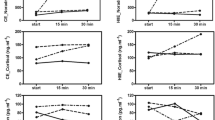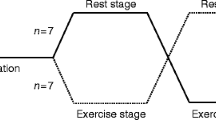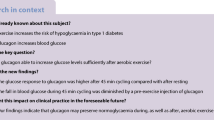Summary
In order to examine the effect of shortacting insulin analogue on the exercise-induced hypoglycaemia in insulin-dependent diabetes mellitus (IDDM) patients we compared the glycaemic response of 40 min cycle ergometer exercise performed either shortly (40 min) or later (180 min) after a breakfast meal and subcutaneous injection of either short-acting insulin analogue [Lys(B28) Pro(B29)] or soluble human insulin (Humulin Regular) in ten IDDM patients with long duration of the disease. Both preparations had been used 1 month before respective studies. Changes in blood glucose, insulin and counterregulatory hormones were assayed. As compared to human insulin, after the analogue injection the peak insulin concentration came earlier, was 56% higher (p<0.05) and disappeared faster, and the postprandial blood glucose response was lower (p<0.05). In the analogue-treated patients the exercise-induced hypoglycaemia was 2.2-fold greater (p<0.01) during the early exercise, but 46% less (p<0.05) during late exercise as compared to the treatment with human insulin. Serum insulin or analogue concentration at the beginning of the exercise correlated closely with the fall in blood glucose during exercise (r=0.74,p<0.01;r=0.73,p<0.02, respectively). In the analogue-treated patients, fasting serum glucagon and adrenalin concentrations were higher than during human insulin therapy (p<0.05) and remained so throughout the study. As compared to soluble human insulin, a much faster absorption of insulin analogue: 1) reduces post-prandial hyperglycaemia, 2) can either augment or reduce exercise-induced hypoglycaemia depending on the time interval between insulin injection and the time of exercise. Since exercise in usually not performed until 2–3 h after a meal, short-acting insulin analogue may be more feasible than soluble human insulin for active IDDM patients. [Diabetologia (1995) 38: 106–111]
Similar content being viewed by others
Abbreviations
- NEFA:
-
serum non-esterified fatty acids
- IDDM:
-
insulin dependent diabetes mellitus
References
Lawrence RD (1926) The effect of exercise on insulin action in diabetes. BmJ 1: 648–650
Moy CS, Songer TJ, LaPorte RE et al. (1993) Insulin-dependent diabetes mellitus, physical activity and death. Am J Epidemiol 137: 74–81
Vranic M, Berger M (1979) Exercise and diabetes mellitus. Diabetes 28: 147–163
Vranic M, Kawamori R, Pek S, Kovacevic N, Wrenshall GA (1976) The essentiality of insulin and the role of glucagon in regulating glucose utilization and production during exercise in dogs. J Clin Invest 57: 245–255
DeFronzo RA, Ferrannini E, Sato Y, Felig P, Wahren J (1981) Synergistic interaction between exercise and insulin on peripheral glucose uptake. J Clin Invest 68: 1468–1474
Wahren J (1979) Glucose turnover during exercise in healthy man and in patients with diabetes mellitus. Diabetes 28 [Suppl 1]: 82–88
Koivisto VA, Felig P (1978) Effects of leg exercise on insulin absorption in diabetic patients. N Engl J Med 298: 79–83
Zinman B, Murray FT, Vranic M et al. (1977) Glucoregulation during moderate exercise in insulin treated diabetes. J Clin Endocrinol Metab 45: 641–645
Brange J, Ribel U, Hansen JF et al. (1988) Monomeric insulins obtained by protein engineering and their medical implications. Nature 333: 679–682
DiMarchi RD, Mayer JP, Fan L et al. (1992) Synthesis of a fast-acting insulin based on structural homology with insulin-like growth factor 1. In: Smith HA, Rivier JE (eds) Peptides: chemistry and biology, Proceedings of the Twelfth American Peptide Symposium. ESCOM, Leiden, Netherlands, pp 26–28
Howey DC, Bowsher RR, Brunelle RL, Woodworth JR (1994) [Lys(B28),Pro(B29)]-Human Insulin, a rapidly absorbed analogue of human insulin. Diabetes 43: 396–402
Torlone E, Fanelli C, Rambotti AM et al. (1994) Pharmacokinetics, pharmacodynamics and glucose counterregulation following subcutaneous injection of the monomeric insulin analogue [LYS(B28),PRO(B29)] in IDDM. Diabetologia 37: 713–720
Kang S, Owens DR, Vora JP, Brange J (1990) Comparison of insulin analogue B9AspB27Glu and soluble Regular insulin in insulin-treated diabetes. Lancet 335: 303–306
Kang S, Creagh FM, Peters JR, Brange J, Volund A, Owens DR (1991) Comparison of subcutaneous soluble Regular insulin and insulin analogues (AspB9,GluB27; AspB10; AspB28) on meal-related plasma glucose excursions in type 1 diabetic subjects. Diabetes Care 14: 571–577
ter Braak EWMT, Bianchi R, Erkelens DW (1993) More suitable action profile for premeal treatment of Lys(B28)Pro(B29) insulin analogue than regular insulin. Diabetologia 36 [Suppl 1]: A30 (Abstract)
Gutman I, Wahlefeld AW (1974) L-(+)-lactate determination with lactate dehydrogenase and NAD. In: Bergemeyer HY (ed) Methods of enzymatic analysis. Academic Press, New York 3: 1964–1968
Miles J, Glasscock R, Aikens J, Gerich J, Haymond M (1983) A microfluorometric method for the determination of free fatty acids in plasma. J Lipid Res 24: 96–99
Laron Z, Mannheimer S (1966) Measurement of human growth hormone. Description of the method and its clinical applications. Israel J Med Sci 2: 115–119
Rolleri E, Zannino M, Orlandini S, Malvano R (1976) Direct radioimmunoassay of plasma cortisol. Clin Chim Acta 66: 319–325
Heding LG (1975) Radioimmunological determination of pancreatic and gut glucagon in plasma. Diabetologia 7: 10–18
Hjerndahl P, Daleskog M, Kahan T (1979) Determination of plasma catecholamines by high performance liquid chromatography with electrochemical detection comparison with radioenzymatic method. Life Sciences 25: 131–138
Welch SG, Boucher DJ (1978) A rapid micro-scale method for the measurement or haemoglobin A1(a+b+c). Diabetologia 14: 209–211
Desbuquois B, Aurbach GD (1971) Use of polyethylene glycol to separate free and antibody-bound peptide hormones in radioimmunoassays. J Clin Endocrinol Metab 33: 732–738
DeFronzo RA, Anders R, Bedsoe TA, Boden G, Faloona GA, Tobin JD (1977) A test of the hypothesis that the rate of glucose fall triggers a counterregulatory hormone response to hypoglycaemia. Diabetes 26: 445–452
Unger RH, Orci L (1981) Glucagon and the A cell: physiology and pathophysiology. N. Engl J Med 304: 1518–1524
Author information
Authors and Affiliations
Rights and permissions
About this article
Cite this article
Tuominen, J.A., Karonen, S.L., Melamies, L. et al. Exercise-induced hypoglycaemia in IDDM patients treated with a short-acting insulin analogue. Diabetologia 38, 106–111 (1995). https://doi.org/10.1007/BF02369359
Received:
Revised:
Issue Date:
DOI: https://doi.org/10.1007/BF02369359




